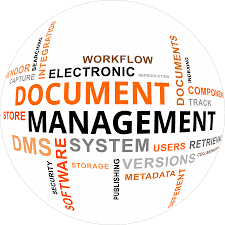We operate in a digital world, which means that as business owners, we must keep up with technological changes that affect our industry. Thus, a document management system is one of these developments. When it comes to creating and maintaining personnel schedules, this software genuinely meets all needs. Therefore, in this post, we shall consider document management software, solutions, and lots more.
Document Management System
A document management system (DMS) is an automated software solution for organizing, securing, capturing, digitizing, tagging, authorizing, and completing activities with your corporate data is a document management system. Despite the fact that most document management systems store data on the cloud, a DMS is much more than that. You can spend more time on the tasks you enjoy because innovative document management systems, such as eFileCabinet, handle the vast amounts of paper that pour into your firm for you.
Document management is the process of processing documents in such a way that information can be efficiently and appropriately created, exchanged, structured, and kept. As a result, firms must understand how to develop a document management system.
Many firms deal with sensitive data that must be kept safe and secure, or accessed promptly. In such cases, a well-functioning document management system is critical. Even if your firm is more informal, it is still necessary to keep accurate records for financial and efficiency reasons.
Document Management System Overview
Most firms nowadays are comfortable working with digital documents and using tools with storage and management capabilities. There is no shortage of document management software or apps, both general and industry-specific, meant to better your company’s handling of electronic information. Hotels, for example, may still use a book-style registry upon check-in and may still seek a signature on a paper credit card tab, but hotels are utilizing OPERA behind the scenes to manage rooms, record notes, and run invoices.
Many small organizations, on the other hand, must deal with a mix of old-fashioned data on paper and electronic files, with the amount of paper data in some situations being substantially higher. As a result, using document imaging technology to convert all of your company’s documents to electronic files is one answer to the challenge of a mixed data environment. Therefore, this could be a pretty simple process, or it could require some ingenuity and specialized approaches, depending on the sort of data and documents you work with.
Document Management Software
In this section of the article, we shall consider 15 document management software.
#1. CannyDoc
Organize official documents and make them easier to find using this document management tool. CannyDocs is an intelligent document management system that can organize professional documents. This functionality also makes it very simple to find and retrieve your documents. CannyDocs is a stand-alone application that allows its users to work with ease. It is OS-agnostic, so you can install it on any device that runs OS.
#2. LogicalDOC
LogicalDOC assists enterprises of all sizes all over the world in gaining control over document management, with a focus on fast content retrieval and business process automation. Therefore, your team can use our service to produce, co-author, and coordinate any number of documents.
#3. Bitrix24
Over 8 million organizations around the world utilize Bitrix24, a free document management tool. Thus, cloud and on-premise options are available (open source code access). Furthermore, file sync, file sharing, mobile access, online and offline document editing, multiuser editing, and more are all available for personal, group, and enterprise drives.
#4. Filehold
Filehold is best suited for large enterprises in areas like manufacturing or healthcare that require information governance. Hence, this is a desktop and mobile document management system that can scale to thousands of users and millions of documents. It can be installed on-premise or in the cloud. Keep your intellectual property safe using two-factor authentication, which is built on Microsoft Service Oriented Architecture. More so, with our e-signature, version control, and OCR solution, you can improve operations and save time and money.
#5. Aptien
Management of the office and employees. Manage and organize your office supplies, equipment, contracts, employee relationships, assets, and other administrative matters. Furthermore, it simplifies your day-to-day employee relationship processes by centralizing them in one place. Say goodbye to your cluttered paperwork, spreadsheets, and apps by managing to onboard, employee compliance, policies, allocated equipment, assets, contract, projects, tasks, and meeting minutes. Aptien may be customized to fit your company’s needs in the same way as LEGO can.
#6. Legito
Document management, smart workflows, approvals, contract assembly, and document automation are some of the issues you solve with Legito. Hence, your Smart Document workspace has it all under one roof. Out-of-the-box functionality gets you set to automate documents that nearly draft themselves in under two hours. More so, Legito is used to handle documents by over 150,000 users in 50 countries, including LexisNexis, Price Waterhouse Coopers, Skoda Auto, and the Societe Generale Group.
#7. ABBYY FineReader PDF
ABBYY® FineReader PDF 15 is a PDF utility for working with digital documents more efficiently. Therefore, FineReader integrates scanned documents into digital workflows and makes it easier to digitize, convert, retrieve, edit, secure, share, and collaborate on all types of documents in the digital workplace, thanks to ABBYY’s AI-based OCR engine.
#8. Bynder
Bynder allows you to create, capture, discover, and distribute digital brands, products, and marketing assets, such as documents. Utilize customized taxonomy structures and in-body text searching to manage your documents.
#9. Xpertdoc
The innovative and intuitive document generation and automation product from. Hence, Xpertdoc allows you to simplify, optimize, and automate consistent processes for the creation, generation, management, delivery, storage, and e-signature of better documents, faster, resulting in improved communications, accelerated business processes, increased productivity, and reduced reliance on IT. We also provide connections with popular CRM platforms and enterprise core systems like ERP, CPQ, ECM, and more.
#10. GoogleDocs
A web-based app designed to store, create, and edit spreadsheets and documents online. Also, templates, chatting, and commenting are available.
#11. Google Drive
File sharing platform that allows users to store and share contacts, photos, videos, presentations, recordings, and more.
#12. Microsoft Excel
Data analysis solution that helps businesses manage spreadsheets, create graphs/charts, perform calculations, share projects, and more. This document management software is widely used
#13. Microsoft 365
An integrated suite of applications includes email, a calendar, and address books that are accessed via the Internet 24/7.
#14. Google Workspace
A suite of collaboration products for teams and SMBs. Web conferencing, file sharing, and scheduling in the cloud. Formerly G Suite.
#15. OneDrive
A web-based digital asset management tool that allows users to access and share files and photos on PC, Mac, Android, and iOS devices.
What is Document Management Systems Used For?
A document management system’s many functions include the safekeeping of sensitive documents, the recording of revision history, and the facilitation of document exchange within an organization.
Assigning keywords and tags to each document in a document management system also makes it simple to locate certain files. Furthermore, these solutions can aid businesses in maintaining compliance with sensitive documents (like those covered by HIPAA) by imposing the necessary security and permission limits on selected important documents.
How Do Document Management Systems Work?
Scanning the paper document or downloading the digital version via email or other applications are both ways in which documents can be captured by a document management system. The next step is indexing, which involves organizing the material according to various criteria (such as tags, keywords, and metadata) in order to facilitate subsequent searches. At last, the paperwork is filed away neatly so that the right people can find it when they need it.
Due to the widespread use of cloud-based document management solutions, users are no longer restricted to their offices in order to access their files. Some vendors of document management software also make their program available as a mobile app, providing users with even more ease and mobility when it comes to accessing their papers.
What are the Most Important Factors of an Effective Document Management System?
The finest document management system will be user-friendly and equipped with features like version control, collaboration tools, mobile access, and file sharing. Because of the first two options, members of your team can collaborate on important documents even when they aren’t physically in the same location. Using version control, you can see a history of who made changes to firm documents and when they were made.
You should also make sure the software you select has robust security measures in place to restrict access to files to just those who need it.
What Features Should You Look for in a Strategic Document Management System?
An effective document management solution is straightforward in both its setup and expansion. Your team’s level of technical proficiency should determine the level of sophistication of the software you use to help them organize and retrieve files quickly and efficiently. Everyone on your team, no matter where they are or what device they’re using, should be able to easily and quickly access and share files and work together within the platform.
Security protocols, access controls, and file versioning are elements that should be present in any decent document management system, but they are of paramount importance in highly regulated businesses. Metadata and tagging capabilities, keyword searching, document revision history and restoration, document retention and deletion automation, picture scanning, optical character recognition, and workflow customization are additional features that enhance the utility of a document management system. The top programs can also easily connect to your existing corporate infrastructure.
What is an Example of a Good Document Management System?
Microsoft SharePoint: is the most all-around effective document management system. SharePoint provides features that are all-encompassing for enterprise content management. Teams are able to edit documents concurrently because of the excellent collaboration options it provides. To become familiar with all of the features offered by the software, it could be necessary for the personnel to undergo further training.
What Makes a Good Documentation System?
The most essential guideline for producing high-quality documentation is to make it look as appealing as is humanly possible. This indicates that we ought to strive to write it in language as clearly as is humanly possible, without skipping any steps in the process. It is important for us to refrain from making assumptions about the level of knowledge possessed by our consumers.
What are QMS and DMS?
Document management systems (DMS) and quality management systems (QMS) are two types of solutions that are commonly used by organizations in the life sciences industry to effectively manage this process. QMSs are used to keep track of processes and controls, while DMSs are used to store and track all documentation that is related to quality.
Document Management Solutions
We shall be looking at how document management solutions have been helping to solve problems in our various firms.
#1. Less Storage Space
The expenditures of storing paper documents might easily build up. After all, you’ll need to buy file cabinets, boxes, and storage bins and make room for them. According to one study, physical document storage takes up about 15% of the overall office area. Furthermore, In the United States, office space costs on average $285 per square foot. Consequently, That’s a lot of money to spend on document storage at that price. This is considered the chiefest of all document management solutions.
#2. Offers Document Backup/Recovery
Not only is storing physical documents pricey, but it’s also risky. A fire, flood, earthquake, or another disaster may destroy years’ worth of valuable information and take a serious toll on your business. Believe it or not, 40 to 60 percent of all small businesses never reopen their doors after a disaster. Unfortunately, though it may be surprising, it’s practically impossible to recover crucial files.
#3. Improves Workflows
In a recent Nintex poll of 1,000 people, 49% said it was difficult to find documents, 43% said it was difficult to share documents, and 33% said document versioning was a problem. That’s rather a waste of time.
Using a document management system, you may streamline procedures and save your team hours. Employees can immediately discover what they need, readily share files, and identify how recent a document is since the system works as a user-friendly, centralized repository. This de-cluttering allows them to focus on more vital duties.
#4. Promotes Better Version Control and Organization
Even if you’ve gone digital, determining if the document management solutions you’re looking at are the most recent versions can be difficult. Remember that according to the Nintex report, 33% of workers had difficulty with version control. Clearly, this can lead to disorder and confusion.
#5. Enables Easy Regulatory Compliance
Every business has its own set of regulations, and following them isn’t always straightforward. According to one recent survey, up to 56% of healthcare providers may not be in compliance with HIPAA right of access. Non-compliance not only exposes you to legal troubles and the possibility of severe fines, but it may also harm your reputation and, eventually, hurt your bottom line.
#6. Grants Wider Access to Documents
One of the most significant drawbacks of physical papers is that they can only be in one place at a time, and creating copies isn’t necessarily efficient or secure. If you invest in a system to manage these files, anyone who requires access to a document will be able to do so without having to wait for someone else to finish it.
#7. Saves Time and Money
Keeping track of paper files is time-consuming and costly. Thus, employees can utilize a document management solutions system to search for what they need by word, phrase, or complete text, saving time and money. Because all documents are saved in the cloud, your staff can achieve their objectives at a lower cost and in less time.
FAQs
Is SAP a document management system?
SAP DMS (Document Management System) is a cross-application component of SAP ECC that provides robust document, content, and digital asset management capabilities. More so, DMS is powered by SAP® NetWeaver™. SAP DMS is a major component of the SAP PLM solution.
How do I set up DMS?
How to Use Amazon DMS to Perform a Database Migration
- Establish a DMS Replication Instance. Begin the process by creating a replication instance, which you’ll use to connect to both databases and perform the migration. …
- Configure the Source and Target Endpoints. …
- Configure a Migration Task and Then Start It.
What is a DMS connection?
DMS Connection Profiles. When defining your source, you create a connection profile that defines the information used to connect to the source database you are migrating from. Hence, these connection profiles are standalone resources, so once you’ve created one, you can re-use it in future migrations.






![Daily Planner: Best Free Apps to Install in 2023[IPHONE & Android]](https://businessyield.com/wp-content/uploads/2023/04/plann-380x220.png)